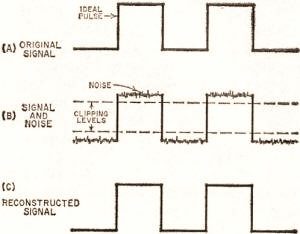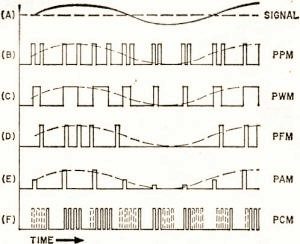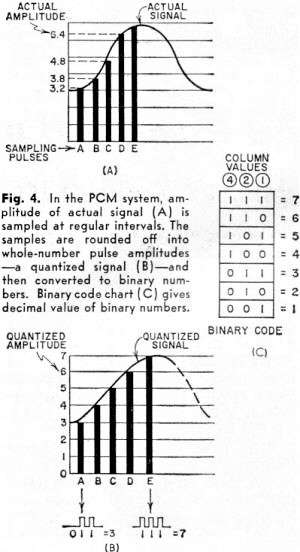
Pulse Modulation
This Exciting Method of Communication is reaching out beyond the Frontiers of Space
Publisher’s Note: To complement Dr. Saleh Faruque’s feature story providing an introduction to RF modulation, as well as Casey Spencer’s feature, Teslapathic, which employs pulse position modulation (PPM), we dug into our archives at Popular Electronics and discovered this terrific introduction to pulse modulation, of which PPM is a variant. In this article, author Herbert Kondo addresses the basics of each type of pulse modulation, as well as their applications. The context of his time, October, 1960, adds a fascinating spin.
***
From Satellite 1959-delta the message came loud and clear: a huge belt of electrons circles the planet Earth thousands of miles out in space. Our 1959-delta had further jolting news: the outer Van Allen radiation belt, once thought to expand after a solar eruption, actually shrinks. Even more striking was the news that there is a huge interplanetary “atom smasher” centered about the sun.
Satellite 1959-delta, commonly known as “Explorer VI,” had a lot more to say. But how it said it is just as interesting as what it said. A great deal of Explorer VI’s information was sent by a five-watt transmitter that used pulse modulation, the most sophisticated modulation system known today. So important is this new communications system that it is already used for telegraphy, radar, multi-channel microwave transmission, and telemetry, as well as space communications.
Basic Theory
The idea of pulse modulation has been around a long time. In telegraphy, the familiar “dots and dashes” of the Morse code are pulses produced with a switch or key. Ham operators have long been using a form of pulse modulation when they key their high-frequency transmitters to send out pulses of electromagnetic energy in code. Television servicemen come across a form of pulse modulation in the gated-beam tube.
The principle behind the pulse modulation system is actually ridiculously simple: information is impressed on a train of pulses instead of directly on a continuous-wave carrier. But if it’s as simple as that, why all the excitement about it? What does pulse modulation have that more familiar forms of modulation – AM and FM – don’t have?
For one thing, pulse modulation offers practically noise-free transmission and reception — even more so than FM. To visualize this concept, let’s consider a train of ideal pulses — pulses with vertical sides, as shown in (A) of Fig. 1. Noise is picked up during transmission, resulting in the waveshape shown in (B). With suitable clipping and limiting circuits, we can reproduce only that part of the pulse signal between the dotted lines, as shown in (C). Having done this, we can then re-transmit this new signal free of noise.

Fig. 1. Original signal amplitude of pulses (A) is affected by noise in transmission (B). Electronic dipping restores original signal (C).

Fig. 2. Information contained in the modulating signal in (A) is shown as it would appear using the various pulse transmission methods (B through F). Binary numbers corresponding to signal amplitudes can be transmitted in the PCM system.
Pulse modulation has another outstanding advantage. It uses transmitter energy more efficiently than either AM or FM because of the simple “on-off” nature of the pulses. This means that a pulse transmitter will have a longer range than an AM transmitter of the same power.
All pulse modulation systems boil down to two basic principles:
(1) A message signal modulates a train of pulses which are applied to a subcarrier. (2) The subcarrier then modulates a high-frequency carrier.
The relation of a subcarrier to a carrier can be made clear by an analogy. Let’s suppose that there are five messenger boys on the same subway train in New York City. Each boy is carrying a message to a different destination (receiver). If we think of the subway as the carrier, then each messenger boy is a subcarrier. The message each boy carries is the modulated signal.
Sampling
The most important idea in pulse modulation is sampling, a concept which we come across almost every day. For example, if you’ve never heard a stereophonic recording, you can listen to a “stereo sample” record and get a good idea of what stereo is like. Another widely known use of sampling is the public-opinion poll which bases its findings on selective sampling techniques.
If we want to transmit a conversation by pulse modulation, we take samples of the conversation — thousands of samples each second — and then transmit them in the same order in which they were spoken. Each pulse is actually a single sample; its height, width, or position indicates the instantaneous value of the sound sent.
For good reproduction, it has been shown that the number of samples per second must be greater than twice the highest frequency of the signal we wish to send. Thus, if the highest frequency in a telephone conversation is 4000 cps, we must take at least 8000 samples each second.
Types of Modulation
Another basic concept in pulse modulation is the modulation itself. When we modulate a carrier wave, we ordinarily alter its amplitude (AM), its frequency (FM), or its phase (PM). The nice thing about a pulse is that there’s another characteristic we can use for modulation, namely, time.
If we alter the timing of the pulses, we are effectively changing their position relative to one another – this is actually done in pulse position modulation (PPM). In pulse width modulation (PWM), we alter the width of the pulses; in pulse frequency modulation (PFM), the frequency of the pulse changes. We can also alter the amplitude of the pulses to produce pulse amplitude modulation (PAM). And we can even code the pulses, as is done in pulse code modulation (PCM).
Let’s take a closer look at all of these pulse modulation techniques and find out how a sine wave — see Fig. 2(A) — is transmitted in each system. Later, we’ll see how pulse width modulation and pulse code modulation are used in transmissions from satellites and in multi-channel telephone communications.
PPM
Pulse position modulation, widely used in radar and in microwave relays, depends on a modulating signal varying the position of the pulses. A separate generator produces a series of marker pulses which act as reference points. With PPM, the relative position of the signal pulse and the marker pulse are important, as shown in Fig. 2(B).
PWM
In pulse width modulation, the width or duration of the pulses varies directly in accordance with the modulating signal, as shown in Fig. 2(C). Also known as pulse duration modulation (PDM), PWM varies either the leading or the trailing edges, or perhaps even both edges, of the pulses. For example, if the leading edges of the pulses were spaced at equal time intervals, the trailing edges could then be varied (displaced in time) in accordance with the amplitude of the modulating signal. Since pulse width modulation requires relatively simple circuitry, it is the ideal type of pulse modulation for use in outer space vehicles.
PFM
Pulse frequency modulation is somewhat similar to ordinary FM, except that the basic carrier consists of equally spaced pulses rather than a sine wave. The occurrence of the pulses varies with the amplitude of the modulating signal, as in Fig. 2(D).
PAM
In pulse amplitude modulation, the height of the pulses varies directly in accordance with the modulating signal, much like the amplitude modulation of a continuous-wave (c.w.) carrier. In Fig. 2(E), the positive-going portion of a sine wave increases the height of the pulse train, while the negative-going portion of the signal decreases the height.

Fig. 3. Satellites can send a number of messages over a single transmitter by sampling each signal with a rotating commutator, then converting the sampled information to PWM signals for transmission to earth.
PCM
Pulse code modulation uses the presence or absence of a pulse to convey information. In the sample shown in Fig. 2 (F), the code makes use of a group of four positions, which may be “filled” with either a pulse or a space (absence of a pulse).
PWM in Outer Space
If we were to make a block diagram of the telemetry system used in the Vanguard rocket, it would break down into the five simple blocks shown in Fig. 3. (See “Telemetering — Vital Link to the Stars,” in the November 1959 issue of Popular Electronics for a complete discussion of telemetry.)
In Fig. 3, a rotating sampling switch – called a commutator – samples a number of contacts which are connected to devices that measure outer space data (cosmic and ultraviolet rays, X-rays, etc.). Information from the contacts is then sent to the keyer which triggers a one-shot multivibrator (itself a special type of PWM generator). With this arrangement, the multivibrator produces pulse signals whose width varies in accordance with the information (voltage) supplied to it by the commutator and keyer. The PWM signals are fed to the oscillator, which modulates the transmitter that sends satellite performance information to earthbound receiving stations.

In the PCM system, amplitude of actual signal (A) is sampled at regular intervals. The samples are rounded off to whole-number pulse amplitudes a quantized signal (B) and then converted to binary numbers. Binary code chart (C) gives decimal value of binary numbers.
“Explorer I,” which discovered the Van Allen radiation belt, also used pulse width modulation. The initial output of the cosmic ray channel, which carried the Van Allen radiation information, was a pulse width signal which then frequency-modulated a subcarrier oscillator. The subcarrier, in turn, phase-modulated the carrier of the satellite’s transmitter. This rather complex sequence of modulation techniques also occurred on the cosmic dust transmissions from Explorer 1.
PCM in Communications
Of all forms of pulse modulation, the most exciting is pulse code modulation. Says a one-time Bell Telephone Laboratories scientist: “It’s the most sophisticated communication technique around. It has the advantage of an extremely high signal-to-noise ratio, plus the added element of secrecy. PCM is statistical in nature, and it’s hard to jam any statistical communication system – the less predictable the system, the harder it is to design electronic countermeasures against it.”
Suppose you bought a VTVM kit for $29.17, tax included. If a friend asked you how much you paid for it, you might tell him that it cost $30.00. Would you be lying? Not at all — you are perfectly justified in rounding off the numbers to the nearest easily remembered figure. People are doing this sort of thing all the time. The same technique is used in pulse code modulation.
For example, if the amplitude of the signal we wish to send is 4.7 volts, PCM would send it through as 5 volts; if the signal amplitude is 2.37 volts, PCM would transmit it as 2 volts. This simplification is necessary because the signal has to be coded, and the code uses only whole numbers.
Let’s suppose we want to send the signal shown in Fig. 4 (A). Sampling pulses sense the amplitude of the signal to be transmitted. Pulse A, which has a value of 3.2 volts, is changed to an amplitude of 3 volts as shown in Fig. 4(B). Pulse B, which has a value of 3.8 volts, is changed to an amplitude of 4 volts. This process of simplifying the original signal in terms of whole numbers is called quantizing the signal; the result is known as a quantized signal – see Fig. 4(B).
Once the signal is quantized, it must be coded for transmission (hence the name, pulse code modulation). For this, the binary code is used (see “The Language of Digital Computers,” Popular Electronics, January 1958, p. 68).
Each quantized pulse representing the amplitude of the signal at a given point must be changed into a group of pulses in the PCM binary code. Always keep in mind this distinction between the quantized pulse and the pulse group: the quantized pulse is a sampling pulse, whose value will be determined by its amplitude; the pulse group represents the original signal in binary language.
In a binary pulse group, only the presence or absence of a pulse has meaning. If the code is a three-pulse group, as shown in Fig. 4(C), then the far-right position has a value of 1 if a pulse is present, or 0 if the pulse is absent. The middle position would have double the first position’s value, or 2, if a pulse were present, but would again have a value of 0 if there were no pulse. The far left position would have double the value of the middle position, or 4, if a pulse were present, but a value of 0 if no pulse were there.
Suppose our quantized pulse has a value of 3. Then, in a three-pulse binary code, there would be a pulse in the far right (1) and middle (2) positions only (1 + 2 = 3). If the quantized pulse has a value of 7, then all three pulses in the group would be needed (1 + 2 + 4 = 7).
With a three-pulse binary group, we can send out the waveshape shown in Fig. 4(B) using any of seven values. For greater “fidelity” in reproducing the waveshape, we would need a large number of samples, and larger binary pulse groups would be required. A five-pulse group, for example, gives 32 different amplitudes; a seven-pulse group gives 128 different amplitudes.
The binary-coded signal is ultimately fed to an r.f. transmitter, which is turned alternately on and off by the binary pulses.
Multiplexing and PCM. Bell Telephone Laboratories has many plans for pulse code modulation. For example, they envision a 24-voice-channel PCM telephone system which would allow 24 people to talk at the same time over a single line.
If you’ve had any experience with present-day “party lines,” you know it’s impossible for two people to talk over the same line at the same time. How, then, can 24 people do it? The answer is multiplexing, a kind of sampling technique. The type used in telephony is time-division multiplexing.
Let’s consider a case where six people are sharing a single telephone line. Three of them are talking in city A and three are listening in city B. By means of a rotating commutator in city A, each speaker is rapidly hooked up to the line in succession. At the same time a second commutator in city B, synchronized with the commutator in city A, samples the line and distributes each speaker’s voice to the intended listener in city B. It’s possible to have as many as 176 simultaneous conversations over a single line using PCM.
Multiplexing, incidentally, is the method used by earth satellites to transmit different types of information back to Earth. Instead of hooking up 24 talkers in sequence, we can hook up 24 transducers which give information about temperature, cosmic ray density, magnetic field strength, etc. Each transducer modulates a subcarrier oscillator, which in turn modulates the regular high-frequency carrier. Both time-multiplexing and PCM were used in the Explorer VI.
PCM offers great possibilities as a television transmission system, and Bell Labs is actively at work on this idea also. In microwave radio, PCM promises practically interference-free transmission. And since a PCM signal is easily applied to magnetic tape, it is ideal for missile and satellite telemetering as well.
Compared to other forms of pulse modulation, PCM has the sole disadvantage of a wider bandwidth requirement. But as telemetry systems move from the lower megacycle bands to the 2200-mc. region, this disadvantage becomes less and less important.
An Exciting Future
Pulse modulation is no longer just theory — it is a reality. Young as it is, pulse modulation is the giant behind the front-page news of space exploration.
As we explore the frontiers of outer space, and as we search for ways to improve and increase the information-handling capacity of our existing communications systems, it becomes increasingly evident that pulse modulation is one of the most exciting developments of modern electronics.
About the Author
Herbert Kondo, 1924 – 2012, served four years in the Army during World War II, graduated from Florida State College, majoring in Physics, and later earned a Master’s Degree in History at The University of Chicago. He worked as Senior Science Editor for MacMillan Company and then was Editor-In-Chief, Science Department, at Grolier/Scholastic Publishing. His books include Adventures in Space & Time – The Story of Relativity (Holiday House, New York, 1966), Albert Einstein and the Theory of Relativity (Franklin Watts, Inc., New York, 1969), The Moon (Franklin Watts, Inc., New York, 1971). In addition to his contributions to Popular Electronics, his articles on the history of science were published in Scientific American and other scientific journals.



